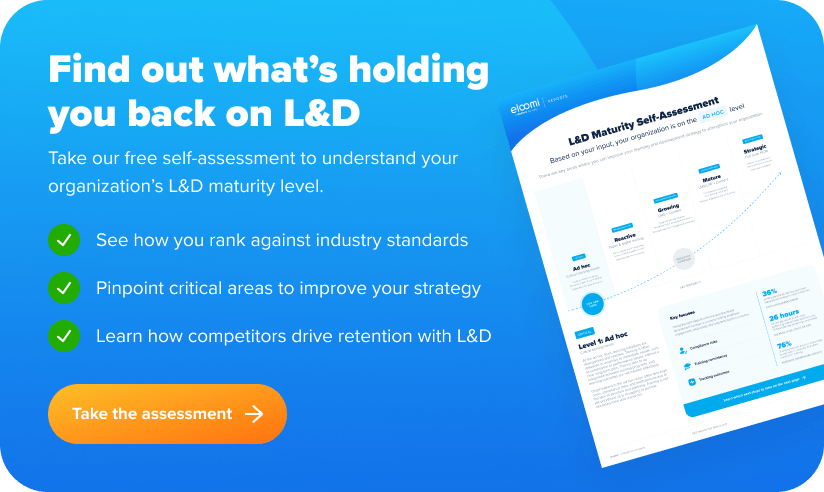However, despite its importance, our recent state of employee retention report uncovered that many organizations struggle with effective retention strategies, with only 23% of companies describing their approach as “advanced” or “top-notch.”
Let’s dig deeper into the common employee retention challenges companies experience, key takeaways from our recent study and practical solutions to keep your team engaged and committed for the long term.
Why is employee retention important?
Turnover costs add up quickly. From recruiting to onboarding, replacing an employee can cost three to four times their annual salary. On top of this, 75% of organizations who took part in our survey report that turnover increases workloads for remaining employees, leading to burnout and even more resignations.
As a result, this can lower productivity as teams lose momentum and valuable expertise disappears. Employee retention helps to avoid these disruptions, maintain continuity and build a workplace where employees feel valued and empowered to perform at their best.

Common employee retention challenges
Understanding why employees leave can help HR and leadership teams plan effective retention strategies. Here are some common challenges that organizations face:
Poor management and leadership
One of the main reasons why employees leave is ineffective leadership. Over 50% of employees mention management-related issues, such as micromanagement, unclear communication and a lack of support as significant turnover drivers. When managers fail to inspire or provide direction, employees often start looking for job opportunities with more supportive leadership. Investing in training for managers can help create a more positive environment and keep employees motivated to stay.
Poor flexibility and work-life balance
With more employees seeking flexibility, companies that lack remote or hybrid work options risk losing valuable team members. More than 40% of employees say that work-life imbalance drives them to look elsewhere and over half of organizations report that flexibility significantly helps retain employees. This shift reflects modern workforce expectations, where employees value the freedom to balance their personal and professional commitments. Companies that support flexible working often see reduced turnover and increased overall happiness.
Lack of recognition
Recognition is a simple but powerful way to show employees they are valued. Yet, a lack of regular recognition can result in disengagement and job dissatisfaction. Our report tells us that over two-fifths of employees leave due to a lack of appreciation. When employees feel that their contributions go unnoticed, they may seek out roles where their work is acknowledged. Building a culture of recognition can boost motivation, foster loyalty and make employees feel appreciated, which ultimately encourages retention.
Poor communication
It’s easy to see how communication issues contribute to misunderstandings and frustration in the workplace. 60% of organizations quote poor communication as a major factor in turnover, as employees who feel out of the loop or uninformed may become disengaged. Clear, open communication is vital for building trust, ensuring alignment and maintaining a healthy organizational culture where employees feel heard and involved.
Low salary and poor benefits
Uncompetitive pay and benefits are major turnover drivers, with 57% of organizations mentioning compensation-related issues as a top reason why employees leave. Salary benchmarking and adjustments to meet market rates can show employees they are valued, but additional benefits such as health, wellness and retirement packages are equally as important. Offering a comprehensive benefits package shows the organization’s commitment to employee well-being, which helps retain staff even in a competitive job market.
Lack of career growth opportunities
A lack of career progression opportunities often drives employees to seek new job opportunities. Around 60% of organizations report that poorly defined career paths contribute to turnover, as employees want to feel they have a future within the company. Regular skill development, training and clear paths for progression can keep employees engaged and reduce turnover by showing them they have room to grow and evolve in their roles.
Lack of purpose
Purpose and alignment with the company’s mission is important for employees. When they feel their work lacks meaning, they are more likely to disengage and consider other opportunities. Building a sense of purpose within your organization can improve job satisfaction, strengthen commitment and ultimately help reduce turnover. By getting employees involved in meaningful projects and aligning their work with broader goals, companies can create a stronger emotional connection resulting in loyalty.
Toxic culture
A toxic work environment, fuelled by high stress, lack of trust, or even workplace bullying, significantly impacts retention. 66% of respondents in our report identify managerial issues as the top culture-related driver of turnover, highlighting how poor leadership and communication can create a negative work environment. On the other hand, a positive, inclusive culture helps build more effective collaboration, improves morale and encourages employees to stay in their role longer by creating a space where they feel respected, appreciated and supported.

How to improve employee retention
No matter what industry, reducing turnover requires a deliberate approach to building a workplace where employees feel valued, supported and motivated. Here are some strategies for improving employee retention:
Offer flexibility and support work-life balance
Allowing employees to manage their personal and professional lives more effectively through flexible options, like remote or hybrid work, has become essential. The data speaks for itself: our state of employee retention report uncovers that more than half of organizations find that flexible work options improve retention by reducing burnout and increasing morale. Prioritize work-life balance to show a commitment to employee well-being, which, as a result, will boost loyalty and satisfaction.
Recognize and reward contributions
Recognition is a simple but impactful way to retain employees. Regular acknowledgment, whether through awards, bonuses, or public praise, reinforces employees’ sense of value within the company. Companies that excel in retention are twice as likely to use rewards and recognition programs, which build a culture of appreciation and long-term commitment. Establishing a recognition program can create a positive environment where employees feel seen and valued for their hard work.
Provide competitive salaries and benefits
Competitive salaries and robust benefits packages are essential in retaining top talent. Regularly reviewing and adjusting pay to match market standards and responsibilities can demonstrate to employees that their efforts are recognized and appreciated. Benefits that support health, wellness and financial security further improve job satisfaction and reduce turnover by meeting employees’ needs.
Provide career growth and development opportunities
Offering clear paths for growth and development keeps employees engaged and invested in their roles. Over half of organizations focus on improving onboarding and training as part of their retention strategies, ensuring employees feel prepared and valued from day one. Opportunities for skill development, mentorship and career progression show employees that the organization is invested in their future, which increases loyalty and reduces turnover.
Encourage a sense of purpose and alignment with values
Aligning employees’ work with the company’s mission can also increase engagement and retention. Nearly half of employees say that a match between personal values and company values has a huge impact on their decision to stay. By clearly communicating the company’s purpose and involving employees in meaningful work, companies can create a fulfilling work environment that strengthens commitment and reduces turnover.
Build and maintain a positive culture
A positive workplace culture plays an extremely important role in retention. Organizations that prioritize employee experience, transparency and inclusivity see higher engagement and job satisfaction. Companies with excellent employee retention rates are twice as likely to focus on cultivating a supportive culture, with initiatives that encourage open communication and recognition programs. By creating a respectful, collaborative environment, companies can build a workplace where employees feel valued and motivated to stay.

Employee retention is a strategic priority
By working through key challenges such as management issues, compensation and culture, organizations can create a more supportive and engaging environment. Prioritizing flexibility, fair compensation, career growth and a positive culture helps build a workplace where employees feel valued and motivated to stay. With intentional strategies and continuous improvement, organizations can build a loyal and high-performing team that drives long-term growth.
Improve employee retention with eloomi
As we saw above, boosting employee retention starts with a supportive environment that values growth and engagement. eloomi makes this simple. As an all-in-one platform, eloomi integrates learning, performance management and communication to nurture continuous development, recognition and strong team connections. With mobile accessibility, seamless HR integrations and a library of targeted elearning content, eloomi supports organizations in meeting modern workforce needs and addressing key retention challenges.
Contact us to discover how eloomi can transform your retention strategy and for further insights, take a look at the latest state of employee retention report.





